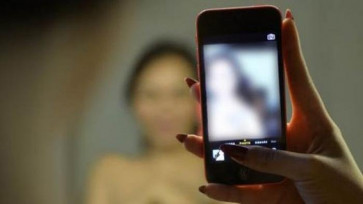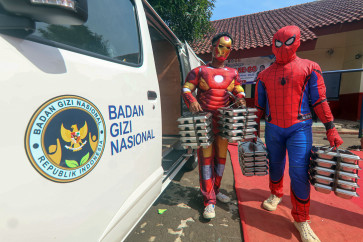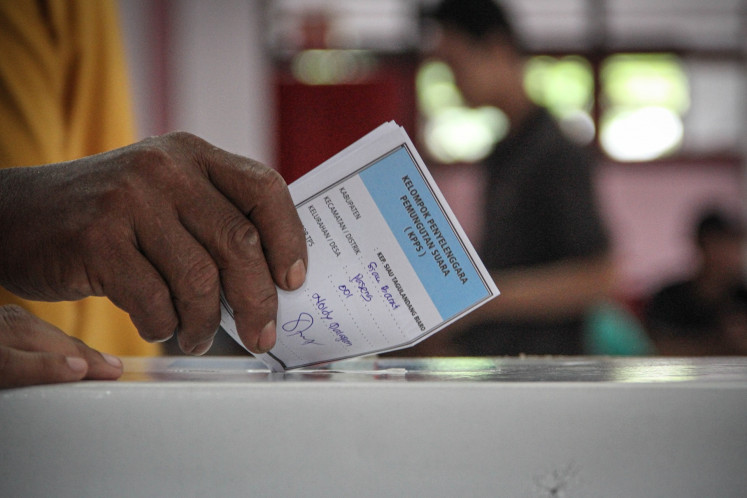Popular Reads
Top Results
Can't find what you're looking for?
View all search resultsPopular Reads
Top Results
Can't find what you're looking for?
View all search resultsBatik history on display
Wet: A batik maker dyes fabric in a large vat
Change text size
Gift Premium Articles
to Anyone
Wet: A batik maker dyes fabric in a large vat.
The old European/Javanese-style building better known as Dalem Wuryaningratan stands out on Jl. Slamet
Riyadi in Surakarta.
The house was named after its first owner, Pangeran Haryo Wuryaningrat, who was the son-in-law of Surakarta Sultan Paku Buwono X (1866-1939).
More than just an antique building, Dalem Wuryaningratan is also home to over 10,000 batik pieces produced between 1840 to 1910.
A batik entrepreneur in Solo, Santosa Doelah, has since 2000 turned the former residence of the Javanese aristocrat into a museum with his collection of thousands of items of batik.
Santosa has collected batik for 30 years. Of the almost 10,000 pieces he owns, 1,500 were obtained from a curator at the Troupen Museum in the Netherlands.
“I am obsessed with bringing back Indonesia’s classic batik kept abroad to show to our children,”
he said.
The museum indeed keeps first-rate batik pieces from the Netherlands and China, as well as items from throughout Java as well as Java’s royal palaces. The museum’s batik exhibits are meant for royal families and their noble relatives, and the collection includes batik with the larangan motifs of royalty.
The public should not wear larangan batik because the patterns are considered sacred, designed only for Javanese kings, princes and officials of the rank of adipati (duke).
“Ajining raga saka endahing busono, physical appearance is valued by what one wears. That’s how palace circles of the past distinguished the nobility from common people,” said museum spokesperson Raden Ayu Febri Dipokusumo.
Febri explained that some of the pieces in the museum’s collection were derived from four palaces: Keraton Kasunanan and Pura Mangkunegaran in Surakarta and Keraton Kasultanan and Pura Pakualaman in Yogyakarta.
From Yogyakarta there are, among others, kemben liris (breast cloths) belonging to the consort of Sri Sultan Hamengku Buwono VII, batik pieces called lereng huk from Pura Pakualaman and dodot wraparounds for palace ceremonies.
Dodot batik, only to be worn by Javanese aristocrats, generally have patterns representing forest scenes, dominated by plain green with
gilded designs.
From the Surakarta palace a set of dodot batik worn by Surakarta Sultan Paku Buwono X in a grand ceremony when he wed Gusti Kanjeng Ratu Emas in 1893 is also on display.
In another corner, Pura Mangkunegaran’s batik pieces include Bogas Pakis, a masterpiece of Nyi Ageng Mardusari — one of the mistresses of the seventh Mangkunegara sultan and famous for her singing and batik-making skill.
The museum, now owned by the Danarhadi batik company, has three display rooms with different batik collections.
The first contains a collection of Dutch batik sarongs with flower, foliage and animal motifs, particularly birds and butterflies, mostly in bright colors. The room’s walls are adorned with photos of Dutch in
batik attire.
“They’re called Dutch batik cloths because originally they were in fact made for the Dutch and Eurasians. This foreign type of batik first appeared around 1840 and reached its peak in the period between 1890 and 1910,” said museum curator Ibu T.T. Soeryanto.
Surakarta and Yogyakarta palace batik collections are in the middle the room. The batik motifs of the four palaces of both regions are almost the same, with the dominance of a soil brown shade.
Surakarta-style batik also has a collaborative version in the form of a blend with coastal (Lasem and Pekalongan) designs, known as Batik Tiga Negeri, with three characteristics and colors: red, blue and brown.
“This museum displays batik clothing and also offers batik knowledge, ranging from its history and philosophy to its method of creation. Every piece of batik on show has its own message,” Soeryanto said.
In terms of philosophy, the curator cited the motif called semen bromo, which was significant in the period of Paku Buwono IV. The motif has eight decorative designs describing the Javanese principle of hastabrata or eight qualities to be possessed by a sovereign.
Batik motifs, according to Soeryanto, also have to do with rituals and spiritual values related to their use. The sidomukti and sidoluhur patterns created by Paku Buwono II, for example, are only used for weddings, because the two possess the values of well-being and high morality.
“Although times have changed, so far Surakarta and Yogyakarta batik creations have never abandoned Javanese philosophical and spiritual principles,” she noted.
The batik versions shown in another room are from China; Jawa Hokokai (influenced by Japanese culture); from coastal regions like Kudus, Lasem and Pekalongan; and from Sumatra, besides merchant, farmer and contemporary varieties.
Cirebon batik, with subtle Chinese influences, has attractive wing patterns alluding to Hindu and old Javanese Mataram culture as well.
The museum also has a special collection of old and unique batik sheets with folklore or legend-based motifs, including those of Snow White. Patterns of fragments of this famous story were designed by women of Dutch-Indonesian descent in the mid-19th century, while the batik making was handled by palace craftswomen.
No less interesting are tools of handmade and stamped batik making, which are hung and attached to room pillars, such as dozens of batik stamps, centuries-old canting or spouted dippers, and other traditional materials like natural dyes for batik.
“Batik isn’t just a matter of shopping and business, it also involves tourism. This museum is open daily to give an opportunity to those wishing to learn more about
batik, through texts as well as by application. Visitors who want to practice batik making can also give it a go,” said Soeryanto, also chairperson of the Sekar Jagad Batik Specialists Board.
On special occasions, particularly during school vacations, the museum offers batik making packages. Museum guests can also watch batik makers at work, from motif designing to batik finishing to be readied for market.
— Photos By Ganug Nugroho Adi










